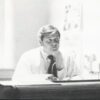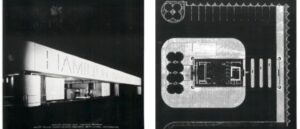Robert B. Church III: The Force Behind a Lasting Legacy

Robert Church III was a modernist architect who designed memorable structures on campus, in Knoxville, and throughout the region.
In the early 1970s, Church served on the faculty of the University of Tennessee, Knoxville’s New School of Architecture, stepping in briefly as the program’s second dean. Though his tenure was tragically short, his legacy has lived on for decades through the Robert B. Church III Memorial Lecture Fund. Established in his memory, the fund has brought many of the world’s most renowned architects and designers to campus to share their work and ideas.
‘A Sheer Force of Personality’
Raised in Atlanta, Church III earned his bachelor’s degree in architecture from Georgia Tech University and his master’s degree from Princeton University. There, he studied under Louis Kahn, one of the most influential architects of the 20th century, who was filling in for a Princeton professor on sabbatical.
After college, Church worked in architectural firms in Atlanta, Little Rock, and Memphis. One of the notable buildings he helped design during these years was the Church of the River, a Unitarian church on the bluffs overlooking the Mississippi River in Memphis.
By 1967, Church had been recruited by Bill Lacy, the founding dean of UT’s New School of Architecture, to join the faculty. When Lacy left in 1970, Church stepped in as acting dean, a role he held until his untimely death.
Church and his wife, Anne, raised their daughters, Tanya and Hollis, in Knoxville. Today, Tanya Craig works as a glass artist in Charleston, South Carolina. Hollis Church, a UT Knoxville graduate with a degree in graphic design, lives in Asheville, North Carolina, and owns Dega Catering—a rock-and-roll tour catering service for major bands.
“I was just 9 when daddy died,” Hollis Church said, adding that her memories of her father are sparse.
“He used to take me to Estabrook Hall with him sometimes. He had an office there. He always had students around. If we weren’t at Estabrook, they’d be at the house.”
She also remembers accompanying her father to his architectural firm’s office.
“I loved going there, too. It was a really cool place. He was always either there or at the university or having a party at home. He and mom entertained a lot. He was a very social person,” she said. “Everybody loved him.”
In recognition of his contributions, Church was posthumously awarded the American Institute of Architects East Tennessee Gold Medal in 1998, honoring his lasting impact on architectural practice and theory.
UT Professor Emeritus Max Robinson, who was the 2007 AIA East Tennessee Gold Medalist, is featured in an AIA video remembering Church as a “big, hulking guy” who stood 6-foot-4, tipped the scales at 250 pounds, and had “a tremendous personality” and a “huge laugh.”
“He had a presence, physically, and he had a personality that went right along with it,” Robinson said. “He influenced a lot of people just by sheer force of personality. He was very magnanimous … always willing to give credit and support and help boost the confidence of what you were trying to do.”
A Modernist Mark
When Church came to Knoxville to teach at UT, he formed a partnership with a former Georgia Tech classmate, W. Glenn Bullock. Their firm merged with McCarty and Associates in 1970 to become McCarty Bullock Church and Holsaple.
Doug McCarty, chairman emeritus of the firm—now McCarty Holsaple McCarty—and 2009 AIA East Tennessee Gold Medalist, said his father, Bruce McCarty, and Church were “my main mentors and their influence is the reason that I fell in love with architecture.
“I will never forget the night that my Dad called me and told me about Bob’s death. He died at the office late one night doing what he loved the most, designing. His passion and his pursuit of the idea is what I strived to do throughout my career.”

On UT’s campus, Church was involved in designing Stokely Management Center and the parking garage adjacent to the old Carolyn P. Brown Memorial University Center. The parking garage, which opened in 1971, was designed with a plaza on the top for gatherings. The University Center garage was demolished in 2012, followed by the University Center itself a few years later, to make room for the new Student Union.
In a 2023 essay in Common Edge, George Dodds, an Association of Collegiate Schools of Architecture (ACSA) Distinguished Professor who was on the UT faculty for 22 years, wrote, “For Church, the garage was more an architecture of spectacle that only happened to house 260 automobiles. The building’s utility was tertiary for him. Anyone taking the time to walk through it understood that it was a formal and spatial tour de force.
“Moreover, this was no object building, as were many of Church’s realized works of the day, aligned with the zeitgeist. Working against type, the garage’s edges were designed to become artful backdrops and settings for varied civic action. As a campus architect, he was far more interested in how the building became part of campus life. It was the student life Church cared about, not parking cars.”
Church also designed the Hamilton National Bank that once stood in Knoxville’s Western Plaza.

When the building was razed in October 2015, Dodds mourned its loss in his “Architecture Matters” column in the Knoxville Mercury: “Another building by one of Tennessee’s finest 20th-century architects was lost in the gap between no-longer-new and not-quite-old-enough. The former Hamilton National Bank building was not the largest of Robert B. Church III’s buildings, nor was it his most elaborate. It was, however, the most distinguished … and easily the finest example of mid-century modern architecture along all of Kingston Pike.”
Carrying the Legacy Forward
After Church’s passing, his widow, Anne, who died in 2013, established an endowment to helped launch the lecture and exhibit series that continues to honor his vision and commitment to architectural education. The inaugural Robert B. Church III Memorial Lecture was held in February 1974, led by none other than Church’s mentor, Louis Kahn. An exhibit of Church’s work was displayed in Estabrook Hall during Kahn’s visit, which turned out to be his final public lecture before his death the following month.
The lecture series and exhibit led to the publication of Robert B. Church III: His Work, a catalog combining photographs, drawings, and Kahn’s lecture text.
Robinson and others combined drawings and photographs from the exhibit of Church’s work with the text of Kahn’s lecture to produce a catalog, “Robert B. Church III: His Work,” later that year.
In addition to the lecture series support, Anne established the Anne P. Church Charitable Endowment supporting 14 organizations in the fields of education, health, religion, human services, and community development through the East Tennessee Foundation. The endowment supports the college’s Anne Purvis Church School of Architecture scholarship.
Among Church’s many students was Lane Lyle, a 1974 UT architecture graduate who remembers him not only as a brilliant architect but as a kind and generous person. He recalls how Church would check in on students working late into the night and then take them out for breakfast.
“Generosity was his middle name,” said Lyle, who now lives in Montana and continues to serve as a director of the architectural firm he once owned. To this day, he sometimes dreams of working alongside Church.
“In those dreams, he didn’t really die,” Lyle said. “He just went to a different place to do architecture.”